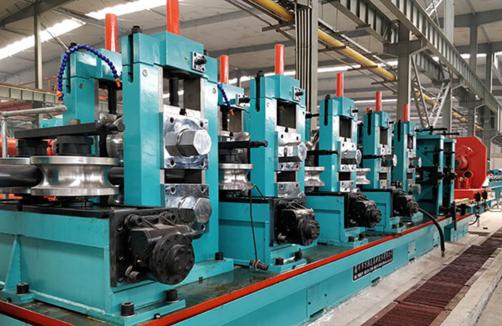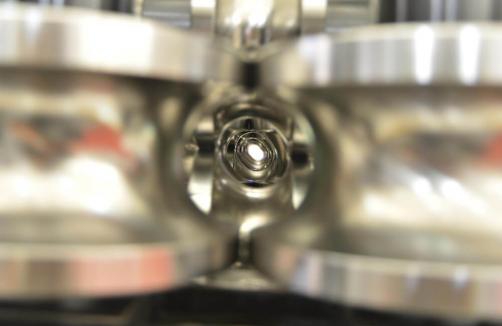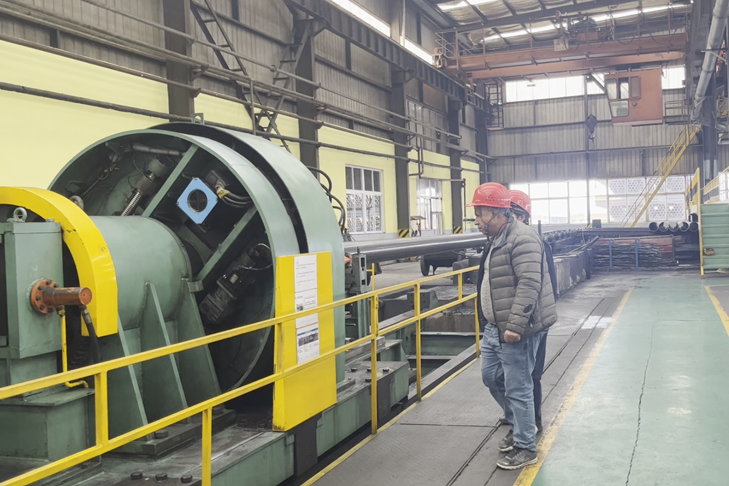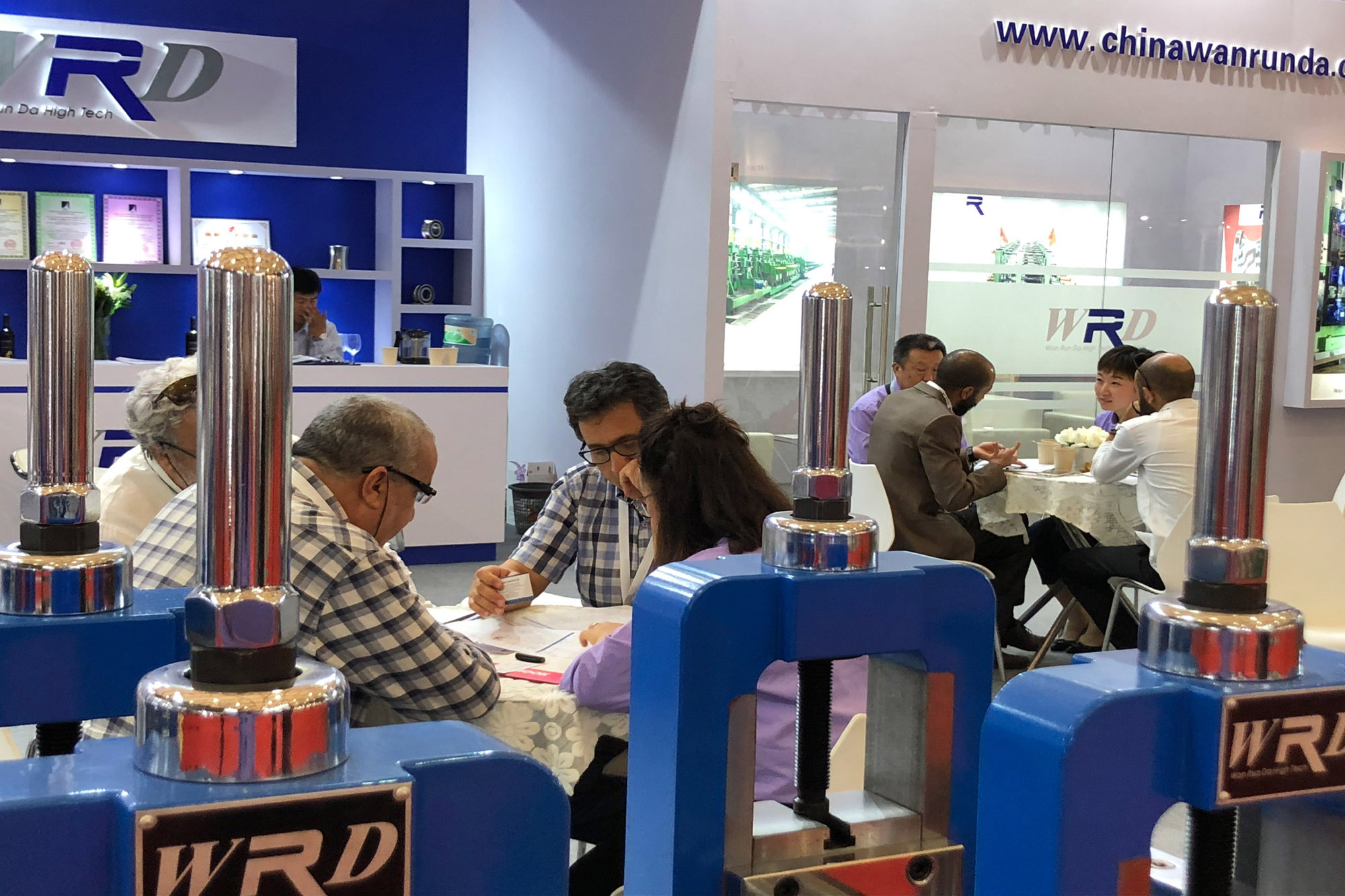The main process parameters of high frequency straight seam welded pipe include welding heat input, welding pressure, welding speed, opening angle, position and size of induction ring, position of impedance device, etc. These parameters have a great influence on improving the product quality, production efficiency and unit capacity of high-frequency welded pipe. Matching the parameters well can make the manufacturer obtain considerable economic benefits.
1. Welding heat input
In the welding of high frequency straight seam welded pipe, the welding power determines the amount of heat input. When the external conditions are certain and the heat input is insufficient, the edge of the heated strip steel can not reach the welding temperature, and it still maintains a solid structure to form cold welding or even fusion. The incomplete fusion caused by too small welding heat input is shown in Figure 1.

Fig. 1 Lack of fusion due to too small heat input
This kind of lack of fusion is usually manifested in the unqualified flattening test, the burst of steel pipe in the hydraulic test, or the crack of weld when the steel pipe is straightened, which is a serious defect. In addition, the welding heat input will also be affected by the quality of the edge of the strip. If there is burr on the edge of the strip, the burr will lead to ignition before entering the welding spot of the extrusion roller, which will cause the loss of welding power and reduce the heat input, thus forming incomplete fusion or cold welding. When the input heat is too high, the edge of the heated strip exceeds the welding temperature, resulting in overheating or even overburning. The weld will crack after being stressed, and sometimes the molten metal will splash and form holes due to the breakdown of the weld. Sand holes and holes formed by excessive heat input are shown in Figure 2.

Fig. 2 Sand holes and holes caused by excessive heat input
During the inspection, these defects are mainly manifested as unqualified 90°flattening test, unqualified impact test, burst or leakage of steel pipe during hydrostatic test.
2. Welding pressure (reduction)
The welding pressure is one of the main parameters of the welding process. After the edge of the strip is heated to the welding temperature, the metal atoms are combined to form the weld under the extrusion pressure of the squeeze roller. The welding pressure affects the strength and toughness of the weld. If the applied welding pressure is too small, the welding edge cannot be fully fused, and the residual metal oxides in the weld cannot be discharged to form inclusions, which will greatly reduce the tensile strength of the weld, and the weld is easy to crack after stress; if the applied welding pressure is too large, most of the metal reaching the welding temperature will be extruded, which not only reduces the strength and toughness of the weld, but also produces Defects such as excessive internal and external burr or overlap welding are found.
The welding pressure is generally measured and judged by the diameter change of the steel pipe before and after the squeeze roller and the size and shape of the burr. The influence of welding extrusion pressure on burr shape is shown in Figure 3.

Fig. 3 Influence of welding extrusion pressure on burr shape
The amount of welding extrusion is too large, the spatter is large and the molten metal extruded is more, the burr is large and turns over on both sides of the weld; the amount of extrusion is too small, almost no spatter, the burr is small and pile up; when the amount of extrusion is moderate, the burr extruded is vertical and the height is generally controlled at 2.5 ~ 3mm. If the amount of welding extrusion is properly controlled, the metal streamline angle of the weld is basically symmetrical, with an angle of 55 ° ~ 65 °. When the extrusion amount is controlled properly, the shape of the metal streamline of the weld is shown in Figure 4.

Fig. 4 metal streamline shape of weld when the extrusion amount is controlled properly
3. Welding speed
Welding speed is also one of the main parameters of welding process, which is related to heating system, weld deformation speed and metal atomic crystallization speed. For high frequency welding, the welding quality increases with the acceleration of welding speed, because the shortening of heating time narrows the width of edge heating area and shortens the time of forming metal oxide; if the welding speed is reduced, not only the heating area is widened, that is, the heat affected area of weld is widened, but also the width of melting area changes with the change of input heat, and the internal burr is also larger. The width of fusion line under different welding speeds is shown in Figure 5. It can be seen from the figure that a better weld can be obtained when the welding speed is higher under the same extrusion amount.

Fig.5 Width of fusion line at different welding speeds
In low speed welding, it is difficult to weld due to the reduction of the corresponding input heat. At the same time, it is easy to cause a series of defects due to the influence of the plate edge quality and other external factors, such as the magnetic properties of the impedance device, the size of the opening angle, etc. Therefore, in high frequency welding, the welding speed should be as fast as possible according to the product specification under the condition of the unit capacity and welding equipment.
4. Opening angle
Opening angle, also known as welding V angle, refers to the included angle of the strip edge before the extrusion roll, as shown in Figure 6. Generally, the opening angle varies from 3° to 6°. The size of the opening angle is mainly determined by the position of the guide roller and the thickness of the guide plate. The size of V angle has great influence on welding stability and welding quality.

Fig. 6 V angle diagram of high frequency induction welding
When V angle is reduced, the edge distance of strip will be reduced, so that the proximity effect of high frequency current will be strengthened, and the welding power or speed will be reduced, and the productivity will be increased. If the opening angle is too small, it will lead to early welding, that is to say, the welding joint will be squeezed and fused before reaching the maximum temperature, which will easily form defects such as inclusions and cold welding in the weld and reduce the weld quality. Although increasing V angle increases the power consumption, it can ensure the stability of edge heating, reduce the loss of edge heat and reduce the heat affected zone under certain conditions. In practical production, in order to ensure the weld quality, the V angle is generally controlled between 4 ° and 5 °.
5. Size and position of induction coil
Induction coil is an important tool in high frequency induction welding, its size and position directly affect the production efficiency.
The power transmitted by the induction ring to the steel pipe is proportional to the square of the gap on the steel pipe surface. If the gap is too small, the production efficiency will be sharply reduced. If the gap is too small, it is easy to be connected with the steel pipe surface and ignited or damaged by the opposite end of the steel pipe. Generally, the gap between the inner surface of the induction ring and the pipe body is about 10 mm. The width of sensing ring is selected according to the outer diameter of steel pipe. If the induction coil is too wide, its inductance will be reduced, the voltage of the inductor will be reduced, and the output power will be reduced; if the induction coil is too narrow, the output power will be increased, but the active loss of the back of the tube and the induction coil will also be increased. Generally, the width of induction ring is 1-1.5d (D is the outer diameter of steel pipe).
The distance between the front end of the induction ring and the center of the extrusion roller is equal to or slightly greater than the pipe diameter, i.e. 1-1.2D is suitable. If the distance is too large, the proximity effect of opening angle will be reduced, resulting in too long heating distance at the edge, so that the welding point can not get a higher welding temperature; if the distance is too small, the extrusion roller will generate higher induction heat, reducing its service life.
6. Function and position of impedance
The impedance magnetic rod is used to reduce the high-frequency current flowing to the back of the steel pipe, and at the same time, the current is concentrated to heat the V angle of the steel strip, so as to ensure that the heat will not be lost due to the heating of the pipe body. If the cooling is not in place, the magnetic rod will exceed its Curie temperature (about 300 ℃) and lose its field. If there is no impedance, the current and the induced heat will be dispersed around the whole tube, which increases the welding power and causes the tube to overheat. The thermal effect of whether there is an impedancer in the tube blank is shown in Figure 7.

Fig. 7 thermal effect diagram of whether there is an impedance in the tube blank
The position of the impedance has a great influence on the welding speed and the welding quality. It has been proved that when the front end of the impedancer is just at the center line of the extrusion roller, the flattening result is the best. When the center line of the extrusion roller is extended to one side of the sizing machine, the flattening result will decrease obviously. When it is less than the center line and on one side of the guide roller, the welding strength will be reduced. The best position is that the impedance device is placed in the tube blank under the inductor, and its head coincides with the center line of the extrusion roller or is adjusted 20-40mm towards the forming direction, which can increase the back impedance of the tube, reduce the circulating current loss and reduce the welding power.
7. Conclusion
(1) Reasonable control of the heat input of welding can obtain higher weld quality.
(2) It is more suitable to control the extrusion amount at 2.5-3 mm. The burr extruded is vertical and the weld can obtain higher toughness and tensile strength.
(3) Controlling the welding V angle to 4 ° ~ 5 ° and producing at a higher welding speed as far as possible under the condition of the unit capacity and the welding equipment, can reduce the generation of some defects and obtain good welding quality.
(4) The width of the induction ring is 1-1.5D of the outer diameter of the steel pipe, and the distance from the center of the extrusion roller is 1-1.2d, which can effectively improve the production efficiency.
(5) Ensure that the front end of the impedancer is right at the cen





